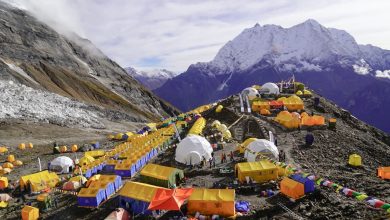Langtang Valley Trek: A Comprehensive Guide

Nestled in the heart of the majestic Himalayas, the Langtang Valley Trek is one of Nepal’s most popular and accessible trekking destinations. Renowned for its stunning natural beauty, diverse flora and fauna, and rich cultural heritage, this trek offers an unforgettable experience for adventurers of all levels. In this article, we’ll explore everything you need to know about the Langtang Valley Trek , from its highlights and best seasons to essential tips and preparation.
Why Choose the Langtang Valley Trek?
The Langtang Valley Trek is often referred to as the “valley of glaciers.” The region’s breathtaking landscapes include snow-capped peaks, lush green forests, and sparkling rivers. It’s a perfect alternative for trekkers looking for an off-the-beaten-path experience compared to the crowded trails of the Annapurna or Everest regions.
Here are some reasons why Langtang Valley is a must-visit:
- Scenic Beauty: The trek offers panoramic views of Langtang Lirung (7,227m), Ganesh Himal, and other towering peaks.
- Cultural Immersion: The region is home to the Tamang and Tibetan communities, allowing trekkers to experience their unique traditions, festivals, and cuisine.
- Biodiversity: Langtang National Park, through which the trek passes, boasts diverse flora and fauna, including red pandas, Himalayan black bears, and an array of bird species.
- Accessibility: Located just 7-8 hours’ drive from Kathmandu, Langtang Valley is one of the most easily accessible trekking destinations in Nepal.
Best Time to Trek
The Langtang Valley Trek is best undertaken during two primary seasons:
- Spring (March to May): This season is marked by blooming rhododendrons and pleasant weather. The temperature is moderate, and visibility is excellent, making it ideal for trekking.
- Autumn (September to November): Post-monsoon months bring clear skies and breathtaking mountain views. The weather is stable, ensuring a comfortable trekking experience.
Winter (December to February) and monsoon (June to August) can also be considered, but they come with challenges like colder temperatures and slippery trails, respectively.
Trekking Itinerary
A typical Langtang Valley Trek lasts 7-10 days, depending on your pace and preferences. Here’s a standard itinerary:
- Day 1: Drive from Kathmandu to Syabrubesi (1,503m) A scenic 7-8 hour drive through winding roads and picturesque villages.
- Day 2: Trek from Syabrubesi to Lama Hotel (2,380m) The trail passes through lush forests and follows the Langtang River, offering glimpses of waterfalls and wildlife.
- Day 3: Lama Hotel to Langtang Village (3,430m) A gradual ascent leads to the traditional Tamang village of Langtang, surrounded by stunning mountain views.
- Day 4: Langtang Village to Kyanjin Gompa (3,870m) The trek continues to Kyanjin Gompa, home to an ancient monastery and a famous cheese factory. This is the trek’s highlight, offering spectacular vistas of the Langtang range.
- Day 5: Acclimatization and Exploration Spend the day exploring the area, including hikes to Tserko Ri (4,984m) or Langshisha Kharka for panoramic views.
- Day 6: Return to Lama Hotel Descend through the same route, enjoying different perspectives of the scenery.
- Day 7: Trek to Syabrubesi and drive back to Kathmandu A final descent followed by a drive back to the bustling capital.
Essential Packing List
Packing wisely is crucial for a successful trek. Here’s a checklist to help you prepare:
- Clothing: Layered clothing (base layers, fleece, down jacket), waterproof jacket and trousers, trekking pants, gloves, and a warm hat.
- Footwear: Sturdy trekking boots and comfortable socks.
- Gear: Trekking poles, backpack (30-40L), sleeping bag (rated for -10°C), and a headlamp.
- Other Essentials: Water purification tablets, sunscreen, sunglasses, first-aid kit, and snacks.
- Documents: Trekking permits (Langtang National Park permit and TIMS card).
Tips for a Memorable Trek
- Acclimatize Properly: Altitude sickness is a real concern above 3,000m. Ascend gradually and stay hydrated.
- Hire a Guide or Porter: While the trail is well-marked, a local guide can enhance your experience by sharing insights about the culture and landscape.
- Respect Local Culture: Dress modestly, ask for permission before taking photos, and follow local customs.
- Support Eco-Tourism: Avoid single-use plastics, carry reusable bottles, and respect the environment.
- Stay Informed: Check weather forecasts and trail conditions before starting your trek.
Cost and Permits
The cost of the Langtang Valley Trek depends on factors like the duration, mode of transport, and accommodations. On average, trekkers spend $25-$50 per day, covering food, lodging, and basic expenses. Hiring a guide or porter adds additional costs.
Permits required for the trek include:
- Langtang National Park Permit: Approximately NPR 3,000 for foreign nationals.
- TIMS Card (Trekkers’ Information Management System): NPR 1,000 for group trekkers and NPR 2,000 for solo trekkers.
Conclusion
The Langtang Valley Trek is an adventure that combines natural beauty, cultural richness, and personal challenge. Whether you’re a seasoned trekker or a first-timer, this journey offers something special for everyone. With proper preparation and a spirit of exploration, the Langtang Valley will leave you with memories to last a lifetime.









